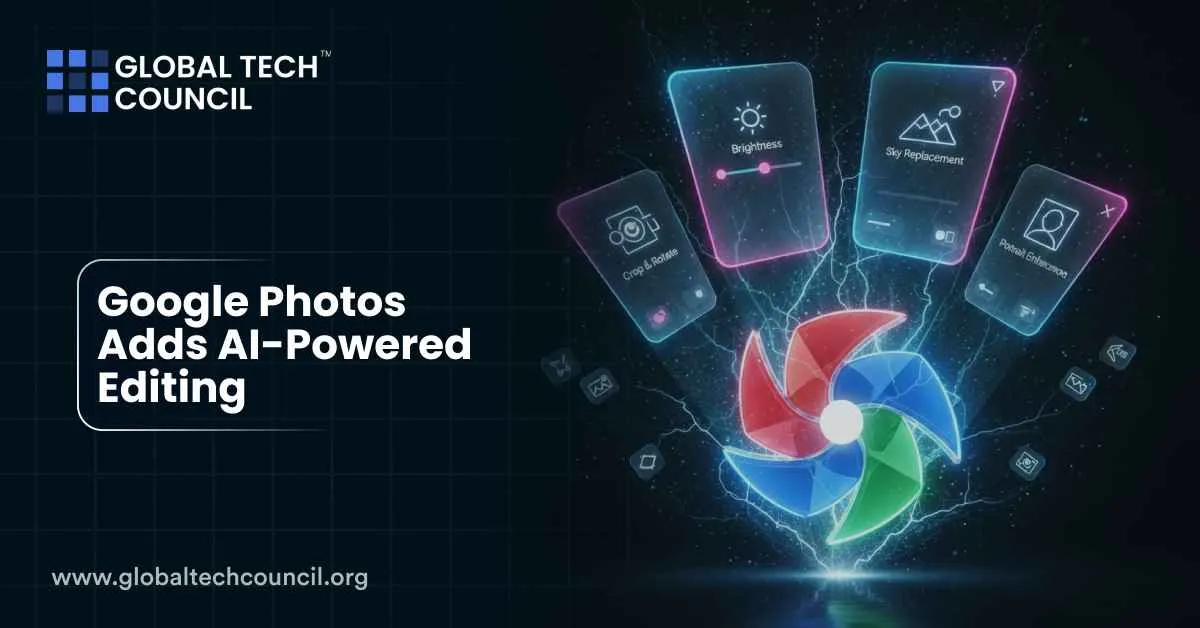
A New Way to Edit Photos
The update transforms how users interact with Google Photos. Instead of tapping through menus or adjusting sliders, you can now type or speak what you want. For instance, commands like “remove the car in the background,” “brighten this picture,” or “make me smile” instantly trigger the AI to perform edits.
The technology behind this breakthrough is Google’s Nano Banana, a generative AI model within the Gemini family. It enables not only object removal or lighting corrections but also creative transformations like turning an image into a painting, adding artistic backgrounds, or applying stylistic effects.
This hands-free approach makes editing accessible for anyone — from casual users to professionals — and demonstrates the growing fusion of AI tools in creative workflows, which is also a major theme in many modern Tech certification programs.
The Role of Natural-Language Editing
At the heart of this update is conversational editing. By tapping “Help me edit,” users can describe what they want, and the AI understands context. For example, saying “make this look like a postcard from Paris” triggers a style adjustment that fits the theme. You can even refine your request with follow-up commands such as “increase brightness slightly” or “remove the blue tint.”
This conversational flow represents a shift from technical precision to intuitive collaboration. Instead of learning how to use complex photo-editing tools, users can now focus on the creative intent while AI handles the technical execution.
Google’s broader goal is to make such smart editing universal — not just a Pixel-exclusive feature. It’s expanding to iOS and across more than 100 countries, supporting over a dozen languages.
Creative Templates and Styles
Beyond functional fixes, Google Photos now offers AI-driven templates that turn ordinary shots into artistic creations. Users can choose from visual styles like “Renaissance painting,” “cartoon sketch,” or “mosaic design.” These styles are powered by Nano Banana’s generative abilities, transforming photos into stylized illustrations while maintaining subject accuracy.
This feature is particularly appealing to content creators, marketers, and social media professionals who want visually unique outputs without spending hours in design software. For people pursuing Marketing and business certification, this update reflects a growing trend — automation enhancing creativity rather than replacing it.
Global Search Expansion
Alongside editing tools, Google has rolled out a major enhancement to Ask Photos, its AI-powered search. Users can now find specific memories through natural language queries. Instead of typing keywords, you can ask, “Show me photos from my birthday at the beach” or “Find the picture where Dad wore a blue jacket.”
The feature uses contextual understanding and image recognition, making search faster and more human-like. It’s now available in over 100 countries and supports 17 new languages, broadening its accessibility worldwide.
Real-World Applications
The implications of these AI-driven tools go beyond convenience. Businesses, educators, and creative professionals can all benefit from these capabilities:
- Marketing Teams: Instantly edit campaign images or tailor visuals for different regions and audiences.
- Educators and Trainers: Use AI-edited visuals to enhance presentation quality or learning materials.
- Small Businesses: Create professional-quality images for product listings and social media with minimal effort.
- Personal Users: Preserve and enhance family memories effortlessly with one-tap suggestions.
Each use case reflects how AI democratizes creativity, turning complex editing tasks into simple conversations.
Ethical and Privacy Considerations
While these tools enhance convenience, they also raise questions about authenticity and digital integrity. Google has addressed this through Content Credentials (C2PA), a system that labels edited or AI-generated photos. This transparency ensures users can identify how an image was altered.
Privacy remains central to Google’s rollout. The company has clarified that edits and prompts are processed securely, and personal photo data is not used for advertising or external training.
Learning from the Technology
For individuals interested in understanding or developing similar AI features, this launch is an excellent learning opportunity. Completing an AI certification equips professionals with knowledge of natural language processing, computer vision, and prompt engineering — the same foundations that power Google Photos’ new capabilities.
Meanwhile, a Tech certification can provide practical insight into how generative AI integrates into consumer products, mobile ecosystems, and cloud services. This cross-disciplinary learning is becoming essential as AI transforms not just technology but design, marketing, and user experience.
AI’s Role in Creative Empowerment
Google Photos’ update embodies a broader trend in AI: shifting power to the user. Instead of replacing human creativity, these tools enhance it. AI handles repetitive work — removing clutter, adjusting tone, correcting color — freeing users to focus on storytelling and design.
Marketers can test creative variations quickly. Artists can explore new styles. Students can experiment with concepts visually. As this democratization continues, the line between “user” and “creator” continues to blur, giving rise to a generation empowered by technology rather than overwhelmed by it.
Professionals pursuing a Marketing and business certification can benefit from understanding how to leverage such tools in brand storytelling, campaign personalization, and social engagement strategies.
Rollout and Future Outlook
The AI editing tools are currently available for Android (especially Pixel users) and are expanding to iOS in the U.S. Google has confirmed a phased rollout for global users in 2025, with continuous updates planned for templates, styles, and supported languages.
The integration of Nano Banana also hints at upcoming cross-app AI features, potentially linking Google Photos with other Gemini-powered services like YouTube, Workspace, and Drive. This interconnected ecosystem could allow users to edit photos, design slides, and create content within one consistent AI framework.
Final Thoughts
Google Photos’ AI-powered editing update marks a leap toward more intuitive and creative technology. It simplifies photo editing, expands discovery through natural language, and gives users artistic freedom with just a few words. Whether you are an enthusiast capturing memories or a marketer curating visual content, this innovation represents the next evolution of digital creativity.
AI is no longer a future concept; it’s an everyday companion, now sitting right inside your photo gallery, ready to edit, enhance, and inspire.